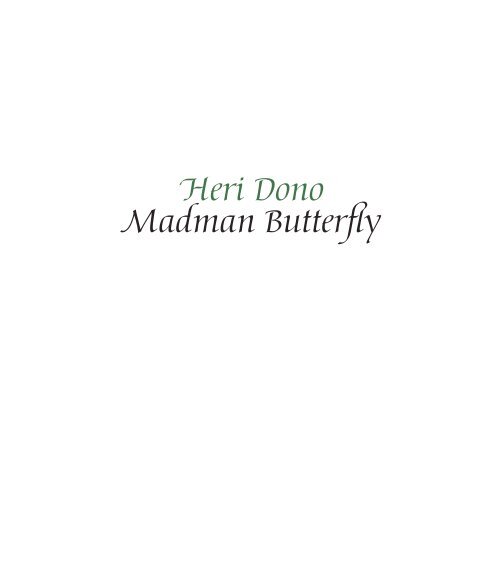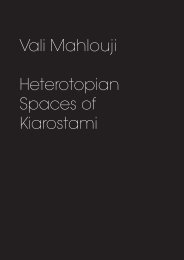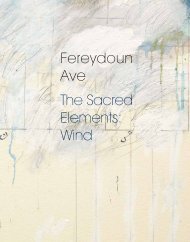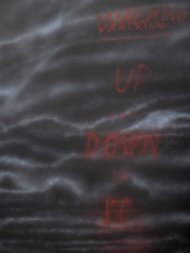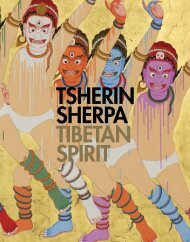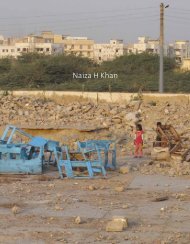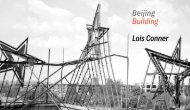Heri Dono Madman Butterfly
Heri Dono Madman Butterfly - Rossi & Rossi
Heri Dono Madman Butterfly - Rossi & Rossi
- No tags were found...
You also want an ePaper? Increase the reach of your titles
YUMPU automatically turns print PDFs into web optimized ePapers that Google loves.
<strong>Heri</strong> <strong>Dono</strong><br />
<strong>Madman</strong> <strong>Butterfly</strong>
<strong>Heri</strong><br />
<strong>Dono</strong><br />
<strong>Madman</strong><br />
<strong>Butterfly</strong>
<strong>Madman</strong> <strong>Butterfly</strong><br />
Sacha Craddock<br />
previous pages:<br />
The Scapegoat Republic<br />
(detail)<br />
2011<br />
acrylic on canvas<br />
150 x 200 cm (59 x 79 in)<br />
<strong>Heri</strong> <strong>Dono</strong>’s work might come with layers of meaning,<br />
expectation, message and irony, but he wants to<br />
keep things simple. He works in a range of media—<br />
installation, painting, theatre and sculpture—as<br />
well as sculpture on wheels, what he calls ‘vehicle<br />
art’, and exhibits his work for local and international<br />
audiences. At one level, at least, he is among the<br />
first internationally celebrated Indonesian artists<br />
to emphasise, even indulge in or play on ‘the local’:<br />
instead of using what used to be called ‘the international<br />
language of art’, the language of magazine<br />
and market, <strong>Dono</strong> draws from within the body of his<br />
native Indonesian society to question its structure<br />
and methods. He says that as an artist he has to<br />
be quick and clever. So in simple ways, he fashions<br />
creatures that straddle the line between the serious<br />
and the souvenir, with no interest in the notion of<br />
the avant-garde.<br />
Indonesia is such a mixture of peoples and its society<br />
is constructed in such a way that <strong>Dono</strong> automatically<br />
functions within a pool of cultural complexity. Born<br />
in Jakarta in 1960, he has maintained a steady and<br />
constant body of work and completed numerous<br />
residencies all over the world, in Australia, Canada,<br />
Germany, the United States and elsewhere. When<br />
he first showed his work abroad in the mid-1990s,<br />
it was perhaps likely to have been appreciated for<br />
being ‘exotic’ as much as anything else. However,<br />
over the past three and a half decades, an increase<br />
in travel during the postcolonial era and the rise of<br />
the Internet have meant that his work can now be<br />
viewed as art in its own right at a global level.<br />
Based in Yogyakarta, the heart of Javanese culture<br />
as well as the centre of Indonesian contemporary art,<br />
<strong>Dono</strong> studied art at the Indonesian Institute of the Arts,<br />
and then learned the craft of wayang kulit, traditional<br />
shadow puppetry. It is an interesting trajectory, to<br />
go from a more contemporary art education to a<br />
craft of which the first performance was recorded<br />
more than a thousand years ago. However, he has<br />
pointed out that his government invests in the past<br />
and encourages the practice of traditional modes of<br />
artistic expression as means of countering new ones.<br />
This trajectory has therefore allowed him to pursue<br />
a substantial career in opposing, undermining or at<br />
least underlining the methods of the State.<br />
In 1996, <strong>Dono</strong>’s first solo show in Britain, Blooming<br />
in Arms at the Museum of Modern Art, Oxford,<br />
brought a fantastic but disturbing set of apparently<br />
half-man, half-tree figures on fine, false<br />
prosthetic legs parading with guns—incorporating<br />
the false legs as a reference to landmines. The<br />
figures all maintain a built theatricality that is<br />
closely associated with his work. Here he made<br />
the point that while the Indonesian government<br />
was launching a campaign to encourage people to<br />
plant trees in a quasi-Green initiative, it was also<br />
systematically deforesting Sumatra, Kalimantan<br />
and Irian Jaya.<br />
In his ‘theatrical work’, <strong>Dono</strong> assumes a given<br />
relationship to the protagonist, a fixed expectation that<br />
devolves from the role of the character in the puppet<br />
theatre that itself originated in Java as well as India<br />
and elsewhere. Through his use of ‘folk’ media,<br />
such as puppetry, which is more about tradition<br />
than either high or low art, he makes a sideways<br />
approach to the obvious. This approach is a long<br />
way away from the ‘Cool Britannia’ of the 1990s<br />
when Young British Artists seemed in total accord<br />
with the desires of the New Labour government.<br />
<strong>Dono</strong> has long played the fool, the pleaser and the<br />
provider of popular experience. Appearing to be<br />
neither complex nor contrary, he uses a robust artistic<br />
stance to bypass formal concern. This well-worn<br />
theatrical device, however, also has a sinister and<br />
tawdry aspect. For Nobody’s Land at Galeri Nasional<br />
Indonesia in Jakarta in 2008, a whole series of angels<br />
with smooth, wood heads and heightened blush<br />
on their cheeks hovered to become perfectly staged<br />
images of freedom. Each—with an open panel at its<br />
chest and beatific smile—appeared to fly. They could<br />
flap their wings yet went nowhere, trapped, as they<br />
were, in their own autonomous world.<br />
All of his three-dimensional works play with<br />
imperfection, insisting that the means for escape<br />
and enchantment is purely theatrical. Flying Golek<br />
(2011) is a veritable chorus line of angels suspended<br />
by wires from the ceiling like puppets. He repeats<br />
figures and images to fill and suit an individual<br />
space, to make a crowd. Each angel, made from a<br />
range of materials, uses the painter’s trick where<br />
the paint not only describes but literally mimics what<br />
it describes. Here, the angels’ heads are actual wayang<br />
golek wooden puppet heads, while the bodies are<br />
made of fibreglass and the wings from papiermâché.<br />
The rounded fibreglass surface protects a<br />
heartlike ‘organ’ crafted from electrical scraps, which<br />
according to <strong>Dono</strong> allude to our ability to mend<br />
and make do. They also remind us of the childhood<br />
disappointment of discovering the trap door for the<br />
battery under the skirt of a talking or crying doll. This<br />
dismantling, or partial disclosure, allows him to point<br />
out the limitation of romantic faith in the possibility<br />
of art. A toy, sculpture or machine can be close<br />
to us technologically, and yet almost, nearly, not working.<br />
The artist’s use of low-tech, low-level wiring recalls<br />
6 7
the early days of stumbling, ambling fallibility, rather<br />
than a smoothly remote-controlled creature that walks<br />
across the stage.<br />
A series of long-nosed automatons in Fermentation<br />
of Nose (2011) sits at numbered desks, staring into<br />
space with somewhat inward-looking, dead eyes.<br />
The mechanised creatures nod in unison and seem<br />
to agree, yet at the same time, the following questions<br />
arise: Who is in charge? Who is listening? Where is<br />
the process of learning directed? Is this a schoolroom?<br />
Who is teaching what, to whom? Is there a<br />
militaristic undertone once again? This use of easy,<br />
visible mechanisation is important to <strong>Dono</strong>; it shows<br />
that the inevitable harnessing of scientific intelligence<br />
by the State can cause trouble.<br />
“I mix animation with animism”, he says. “Both are<br />
based on the belief that everything has a soul. From<br />
this point, I make sociopolitical commentary using<br />
humour”. The mechanisation suggests something<br />
that stumbles, something that can be overpowered,<br />
broken down and usurped. It is perfect. Yet instead<br />
of formal questioning, this artist starts with a projection<br />
into each of his characters, whether painted, sculpted,<br />
mechanised or performed. There is definitely a truth,<br />
a reality, to each character. The faith put into a puppet is<br />
like that of a toy: a child knows that the toy is ‘real’<br />
and, in formal terms, it is.<br />
Rather than expressionism—a bearing of the soul—<br />
for <strong>Dono</strong>, humour is key. He uses the tactics of<br />
animated film, the familiarity of cartoons, where<br />
legs spin for hours over the side of a cliff before the<br />
character eventually drops. With a deep knowledge<br />
of and love for children’s cartoons, animation and<br />
comics, he incorporates the theatrical structure of<br />
pretence, action, narrative and change into his work.<br />
He is inspired by historical sources—from Romanesque<br />
manuscripts to Javan painted scrolls, and from<br />
the Beano to Dan Dare to Manga comics—in which<br />
artists have drawn narration across the page as a<br />
simple device to show the passage of time; where<br />
the narrative scans through squares in the same<br />
way that film runs through the gate of a projector.<br />
It is always difficult for an artist to compete with<br />
the narrative created by mechanisation and film.<br />
The inanimate object can be distressing for an art<br />
student: “This thing just does not do enough”. Yet<br />
<strong>Dono</strong> successfully harnesses the history of theatre<br />
through repetitive movement and the circularity of<br />
narrative tale-telling, and manages, in his painting,<br />
sculpture, installation and performance, to thwart<br />
the emptiness that can surround the contemporary<br />
art object.<br />
<strong>Dono</strong> not only indulges in ‘the local’, but also creates in<br />
a very localised context; the desire to appeal internationally<br />
has never really entered his work. It is<br />
important, though, to consider the aforementioned<br />
changes that have taken place over the time he has<br />
been working, and their impact on the emergence<br />
of an ‘international’ language and the role of artists<br />
to represent exactly the opposite. This is not to say<br />
that there is such an extreme polarisation between<br />
the local and the international. But for this artist, the<br />
use of traditional methods means a deliberate desire<br />
to immerse himself in exactly the most obvious<br />
place—in tradition—in order to undermine or look<br />
properly at the State in which he lives. Indonesia has<br />
a Muslim population of more than two hundred<br />
million, larger than any other country in the world,<br />
yet Hinduism, Christianity and Buddhism are also<br />
Salto Mortale (Terjun Bebas)<br />
2011<br />
acrylic on canvas<br />
200 x 300 cm (79 x 118 in)<br />
not included in the exhibition<br />
represented there. Indonesia is so large, its population so<br />
culturally varied, that a recent news report suggested<br />
a ban on noisy children who parade the streets at<br />
3:00 a.m. to wake Muslims to eat during Ramadan in<br />
order to respect the rights of non-Muslims to a good<br />
night’s sleep.<br />
It could be said that <strong>Dono</strong> not only quotes from and<br />
uses the traditional art form of wayang, with its use<br />
of outline, extreme distortion and comic storytelling, but<br />
that he is reviving it, making it actual, real and active<br />
today. Puppetry is encouraged as part of a so-called<br />
‘Javanisation’ of Indonesia. There is also the tendency<br />
to use more popular art forms to reinvestigate<br />
practice. In Indonesia, art is a very powerful medium<br />
that has, especially through decades of theatre, carried<br />
the tradition not only of criticism of the State but<br />
also of subversion (through underground news and<br />
notices). Puppetry, a distinct ‘world within a world’,<br />
has the contained confines of the State that are ideal<br />
for make-believe, just as the European characters<br />
Punch and Judy carried the news of the day; insights<br />
into the relationship between a husband, wife and<br />
baby; a string of sausages and sometimes even<br />
the obligatory crocodile. But such fixed images and<br />
rules, used over and over, can become formulaic, and<br />
therefore invisible.<br />
When it comes to painting, <strong>Dono</strong> has a consistent yet<br />
questioning relationship. At one point, he even said<br />
that he was not very interested in making paintings<br />
because they had become so much of a commodity. He<br />
did, however, train as a painter, and admires painting<br />
as a traditional art form. So he uses the medium, he<br />
says, as a ‘diary of life’, as a way of bringing together<br />
layers of historical understanding. The characters in<br />
his Salto Mortale (Terjun Bebas) (2011), for instance,<br />
contain these layers, and at the same time, use<br />
action: little creatures leap from two typical <strong>Dono</strong><br />
vehicles, painted representations of his ‘vehicle art’,<br />
8 9
flying like suicidal swifts to jump up and down<br />
and then out into a perilously full toilet bowl. He<br />
achieves a real rush with this work. His subjects,<br />
part historical, part cartoon, do what they would in<br />
character, acting out, over and over again. Although<br />
it is generally accepted than an artist is free to paint<br />
whatever he or she wants, for this artist the continual<br />
reinvestment in a repertoire of characters is<br />
key. Instead of reinventing the alphabet, he looks<br />
to comedic TV cartoons in works such as Going<br />
Away from the Television Life (2008), which also has<br />
an affinity with Liberty Leading the People (1830) by<br />
Delacroix. A true artist of the world, <strong>Dono</strong> studied<br />
the work of Klee, Miró, Picasso and Kandinsky at<br />
art school. While he expertly uses the characters of<br />
puppetry, the Javanese wayang scroll stories and<br />
lukisan kaca (the anonymous art of reverse-painting<br />
on glass from northwest Java), he is fascinated<br />
by merging himself and his work with Western<br />
concepts as well as with ideas of the retention and<br />
denial of authorship.<br />
The perhaps oversimplified distinction between<br />
colonial and postcolonial painting in Indonesia, the<br />
‘East versus West’ dichotomy, is represented by more<br />
traditional painting styles, such as work by mainly<br />
Dutch artists visiting the colonies. But it is also seen<br />
in work by Indonesian artists, which similarly makes<br />
for lovely landscape painting with little reference to<br />
a real, live context. Just after Indonesia’s four-year<br />
war of independence from the Dutch, and the handover<br />
of sovereignty in 1949, a group of artists called<br />
for a ‘new and nationalistic art form’, and decided<br />
they would reject the old colonial view, exemplified<br />
by the Mooi Indie, or ‘beautiful Indies’, representation<br />
of landscape.<br />
From Mexico to Indonesia, mountains have always<br />
provided special sources of power and inspiration<br />
for artists. The mountain is symbolic in Indonesian<br />
culture; it designates a ‘spiritually charged’ site<br />
where discussion between gods and mortals can<br />
take place, and from which gods can descend to the<br />
Earth. In Indonesia, artists are traditionally seen as<br />
mediators between the mystical and the real. <strong>Dono</strong>’s<br />
painting, The Sadness Spirit of Mount Merapi (2010),<br />
shows a sickness within the mountain: the figure of<br />
the spirit in the mountain lies ill within the outline<br />
of the projecting landmass. It has long been said<br />
that when Merapi erupts, great political change will<br />
touch the world. Since Merapi erupted in November<br />
2010—an eruption so powerful that a nearby<br />
river dried up and steam rose from the ground for<br />
months afterwards—it is believed that there really<br />
has been a seismic shift in the world.<br />
His recent paintings are lavish with imagery and<br />
incorporate rich colours. In The Escape King of<br />
Thief (2011), for instance, each character carries<br />
the same telltale tongues, along with wheels and<br />
mechanised potholes inside his or her chest. Other<br />
works show us the range of <strong>Dono</strong>’s invention: wine<br />
falls out of holes in various bodies and fills the<br />
surface of the canvas; there are nails, many eyes,<br />
bicycle people, automatons, bad greedy animals and<br />
animated creatures celebrating the bounty. Pinocchio<br />
is lying; he has a very long nose and eyes like little<br />
snouts; there are extended antennae, two eyes, three<br />
eyes, two nostrils and high colour. In The King of<br />
Peace ‘Jaja Perdamaian’ (2011), a hybrid character—<br />
a conglomerate of a current politician and a mythological<br />
figure—is automated, multidirectional, with<br />
holes or stigmata on his hands, crumpled arched<br />
arms and tongues of fire with wine falling out of<br />
the bottom of his mechanical bodywork into a very<br />
small glass. Berebut Pepesan Kosang (2009) depicts<br />
snapping, pushy Ninja-type characters with split,<br />
serpent-like tongues and small sexual organs facing<br />
each other over a running stream. Each wears red<br />
boots and sports a miner’s lamp on his head. There is<br />
a strong sense of pace and movement as they push<br />
forward across the water, which works its way back<br />
to the far corner, creating an illusionary space.<br />
<strong>Dono</strong> treats the subjects of his paintings in very<br />
much the same way as he treats the three-dimensional<br />
‘pupils’ at their desks. Yet with these almost perfunctory<br />
paintings, he really clowns around. After all, as <strong>Dono</strong><br />
so brilliantly shows, the painting is the ‘trying-out’<br />
place where relationships can be invented, and<br />
characters can jump and spin and stand on each<br />
other without repercussion.<br />
Sacha Craddock lives and works in London. She is the<br />
Chair of Bloomberg New Contemporaries, Chair of<br />
Braziers International Artists Workshop, Co-founder of<br />
ArtSchool Palestine, Public Art Advisor for the Royal<br />
Borough of Kensington and Chelsea and, currently, Director<br />
of Programme at Max Wigram Gallery. From 2003 to<br />
2011, she was Curator at Bloomberg SPACE and Postgraduate<br />
Tutor at the Royal College of Art and Royal<br />
Academy Schools.<br />
following pages:<br />
Two Clown Heads with Angels<br />
(detail)<br />
2011<br />
acrylic on canvas<br />
150 x 200 cm (59 x 79 in)<br />
10<br />
11
Plates
16<br />
Flying to the Angels’ Freedom<br />
2011<br />
acrylic on canvas<br />
150 x 200 cm (59 x 79 in)
18
previous pages:<br />
Merdeka atau Belum<br />
2011<br />
acrylic on canvas<br />
150 x 200 cm (59 x 79 in)<br />
opposite:<br />
Garuda Extraterrestrial<br />
2007<br />
acrylic on canvas<br />
150 x 200 cm (59 x 79 in)<br />
20
22<br />
Olympia Released the Bad Spirit<br />
2011<br />
acrylic on canvas<br />
150 x 200 cm (59 x 79 in)
opposite:<br />
Mati Ketawa ala USA<br />
2011<br />
acrylic on canvas<br />
200 x 150 cm (79 x 59 in)<br />
following pages:<br />
The King Frog<br />
2011<br />
acrylic on canvas<br />
150 x 200 cm (59 x 79 in)<br />
24
26
28
previous pages:<br />
The Big Brother<br />
2011<br />
acrylic on canvas<br />
150 x 200 cm (59 x 79 in)<br />
opposite:<br />
The Scapegoat Republic<br />
2011<br />
acrylic on canvas<br />
150 x 200 cm (59 x 79 in)<br />
30
32<br />
Three Presidential Candidates<br />
2009<br />
acrylic on canvas<br />
150 x 200 cm (59 x 79 in)
34<br />
Two Presidential Candidates<br />
2008<br />
acrylic on canvas<br />
150 x 200 cm (59 x 79 in)
36<br />
Two Clown Heads with Angels<br />
2011<br />
acrylic on canvas<br />
150 x 200 cm (59 x 79 in)
38<br />
War Culture<br />
2008<br />
acrylic on canvas<br />
200 x 150 cm (79 x 59 in)
Biography
Born in Jakarta, 12 June 1960<br />
Currently resides in Yogyakarta<br />
<strong>Heri</strong> <strong>Dono</strong> is unquestionably one of Indonesia’s foremost<br />
contemporary artists. Best known for his installations that are<br />
inspired by experiments with wayang, the popular Javanese folk<br />
theatre, he has participated in exhibitions and workshops in<br />
Asia, Australia, Europe and the United States.<br />
In wayang, a number of elements—visual arts, singing, music,<br />
storytelling, mythology, promotion of a philosophy of life, social<br />
criticism and humour—merge to create a coherent performance.<br />
These elements are coupled with wayang’s unique<br />
setting, which provides space for social interaction with the<br />
audience. Through his complex multimedia installations and<br />
performances, <strong>Dono</strong> creatively revitalises this traditional art<br />
practice and harnesses the power of performance and interactivity.<br />
As a result, his works engage in intense dialogues with<br />
their audiences.<br />
<strong>Dono</strong>’s paintings depict wild deformations and free fantasies,<br />
out of which emerge characters of wayang stories. His profound<br />
knowledge of children’s cartoons, animated films and comics is<br />
also reflected in his canvases, which are filled with the highly<br />
astonishing characters of intertwined fantastic and absurd<br />
stories. Into many of these works, <strong>Dono</strong> inserts his own critical<br />
remarks on sociopolitical issues in Indonesia and abroad.<br />
Education:<br />
1987–88<br />
Studied Wayang KuIit with Sukasman in Yogyakarta, Indonesia<br />
1980–87<br />
Indonesia Institute of the Arts, Yogyakarta, Indonesia<br />
RESIDENCIes:<br />
2008<br />
Workshop, Flinders Medical Centre, Flinders University, Adelaide,<br />
Australia<br />
2007<br />
Artist in Residence, Ernst Busch University, Berlin, Germany<br />
Artist in Residence, University of South Australia, Adelaide, Australia<br />
2006<br />
Artist in Residence, Humboldt University, Berlin, Germany<br />
2005<br />
Artist in Residence, Australian Print Workshop, Melbourne,<br />
Australia<br />
The International Jury of the Xl Triennial India, New Delhi, India<br />
Artist in Residence, United Sardine Factory, Bergen, Norway<br />
Artist in Residence, Australia Indonesia Arts Alliance, Byron Bay,<br />
Australia<br />
2004<br />
Workshop with DIDA Escola de Música, São Salvador de Bahia, Brazil<br />
Sound Art Seminar, Kunstakademiet Bergen, Bergen, Norway<br />
Fellowship for Curatorial Work, IFA Institute, Stuttgart, Germany,<br />
in Ethnologisches Museum, Berlin, Germany<br />
2003<br />
Artist in Residence, Australian Print Workshop, Melbourne, Australia<br />
Contemporary Asian Art Forum, Links, Platforms, Networks, Asian<br />
Art Archive, Hong Kong<br />
2002<br />
Artist in Residence, Western Front Society, Vancouver, Canada<br />
Artist in Residence, Queensland College of Art, South Bank, Australia,<br />
and Queensland University of Technology, Brisbane, Australia<br />
Artist in Residence, National Institute of Education, Singapore<br />
2000<br />
Artist in Residence, Vermont Studio Center, Johnson, USA<br />
1999<br />
Cyfuniad International Artists’ Workshop, Wales, UK<br />
Artist in Residence, Queensland College of Art, Brisbane, Australia<br />
Artist in Residence, University of Auckland, Auckland, New Zealand<br />
1996<br />
Artist in Residence, Townsville, North Queensland, Australia<br />
1995<br />
Artist in Residence, Museum of Modern Art, Oxford, UK, with<br />
Institute of International Visual Arts, London, UK<br />
1990–91<br />
International Artists Exchange Program, Christoph Merian Stiftung,<br />
Basel, Switzerland<br />
Selected Solo Exhibitions/Projects:<br />
2011<br />
Pinocchio Syndrome, Hong Kong International Art Fair, Hong<br />
Kong, organised by Edwin’s Gallery, Jakarta, Indonesia<br />
Hommage an Raden Saleh, Schloss Maxen, Dresden, Germany<br />
The Lost Magician, Alexander Ochs Galleries, Berlin, Germany,<br />
and Beijing, China<br />
2009<br />
Comedy of Error, Jan Manton Art, Brisbane, Australia<br />
The <strong>Dono</strong> Code, Tropenmuseum, Amsterdam, The Netherlands<br />
<strong>Heri</strong>donology, Jogja Gallery, Yogyakarta, Indonesia<br />
Shadow of Trojan Horse, Galeri Tondi, Medan, North Sumatera,<br />
Indonesia<br />
2008<br />
Post-Ethnology Museum, Gaya Art Space, Ubud, Bali, Indonesia<br />
Nobody’s Land, Galeri Nasional Indonesia, organised by Edwin’s<br />
Gallery, Jakarta, Indonesia<br />
Ose Tara Lia—I see nothing, Oz Asia Festival, Artspace, Adelaide<br />
Festival Centre, Adelaide, Australia<br />
<strong>Heri</strong> <strong>Dono</strong>: Pleasures of Chaos, Walsh Gallery, Chicago, USA<br />
The Dying King & I, Nadi Gallery, Jakarta, Indonesia<br />
2007<br />
Angels: Bang! Bang!, Sherman Galleries, Sydney, Australia<br />
The Dream Republic, South Australian School of Art Gallery, University<br />
of South Australia, Adelaide, Australia<br />
2006<br />
<strong>Heri</strong> WAR <strong>Dono</strong>, Soemardja Gallery, Bandung, Indonesia<br />
Civilization Oddness, Walsh Gallery, Chicago, USA<br />
2005<br />
Free-D.O.M., Stiftelsen 3,14, Bergen, Norway<br />
2004<br />
Who’s Afraid of <strong>Dono</strong>saurus?, Galeri Nasional Indonesia, Jakarta,<br />
Indonesia, organised by Nadi Gallery, Jakarta, Indonesia<br />
2003<br />
Upside Down Mind, Circle Point Art Space, Washington, D.C., USA<br />
<strong>Heri</strong> <strong>Dono</strong>, Australian Print Workshop, Melbourne, Australia<br />
<strong>Heri</strong> <strong>Dono</strong>: A Spiritual Journey, Semarang Gallery, Semarang,<br />
Indonesia<br />
2002<br />
Interrogation, Center A, Vancouver, Canada<br />
<strong>Heri</strong> Provokes <strong>Heri</strong>, Nadi Gallery, Jakarta, Indonesia<br />
Free-D.O.M., Bentara Budaya, Jakarta, Indonesia<br />
Reworking Tradition I & II, Singapore Art Museum, Glass Hall,<br />
Nanyang Playhouse, National Institute of Education, Singapore<br />
2001<br />
The Trap’s Outer Rim, Cemeti Art House, Yogyakarta, Indonesia<br />
Fortress of the Heart by <strong>Heri</strong> <strong>Dono</strong>, Gajah Gallery, Singapore<br />
2000<br />
<strong>Heri</strong> <strong>Dono</strong>: Dancing Demons and Drunken Deities, Japan Foundation<br />
Forum, Tokyo, Japan<br />
Humor and Rumor in Republic of Cartoon, Nadi Gallery, Jakarta,<br />
Indonesia<br />
1999<br />
Mythical Monsters in Contemporary Society by <strong>Heri</strong> <strong>Dono</strong>, Gajah<br />
Gallery, Singapore<br />
Virtual Reality, Erasmus Huis, Jakarta, Indonesia<br />
Tirtara, French Cultural Center, Yogyakarta, Indonesia<br />
1997<br />
Tanah dari Merapi, French Cultural Center, Yogyakarta, Indonesia<br />
1996<br />
Blooming in Arms, Museum of Modern Art, Oxford, UK<br />
1993<br />
The Chair, Canberra Contemporary Art Space, Canberra, Australia<br />
1991<br />
Unknown Dimensions, Museum der Kulturen, Basel, Switzerland<br />
1988<br />
Cemeti Contemporary Art Gallery, Yogyakarta, Indonesia<br />
Mitra Budaya Indonesia Gallery, Jakarta, Indonesia<br />
Bentara Budaya, Yogyakarta, Indonesia<br />
Selected Group Exhibitions/Projects:<br />
2011<br />
Negotiating Home, History and Nation: Two Decades of<br />
Contemporary Art in Southeast Asia 1991–2011, Singapore Art<br />
Museum, Singapore<br />
Art I Jog I 11, Taman Budaya Jogjakarta, Yogyakarta, Indonesia<br />
Pameran Besar Patung Kontemporer Indonesia: Ekspansi, Galeri<br />
Nasional Indonesia, Jakarta, organised by SIGIarts, Jakarta, Indonesia<br />
Jakarta Berlin Arts Festival, foyer art performance, Admiralspalast,<br />
Berlin, Germany<br />
Trans-Figurations: Mythologies Indonésiennes, Espace Culturel<br />
Louis Vuitton, Paris, France<br />
Indonesian Eye: Fantasies & Realities, Ciputra World Marketing<br />
Gallery, Jakarta, organised by Parallel Contemporary Art, London, UK<br />
Opera Jawa, collaboration performance with Garin Nugroho,<br />
Musée du Quai Branly, Paris, France<br />
Art Stage Singapore, Marina Bay Sands, Singapore, organised by<br />
Vanessa Art Link, Jakarta, Indonesia<br />
Do It, Kunsthalle Faust, Hannover, Germany<br />
1001 Doors: Reinterpreting Traditions, Ciputra World Marketing<br />
42 43
Gallery, Jakarta, organised by ArtSociates Lawangwangi, Bandung,<br />
Indonesia<br />
Castlemaine Visual Arts Biennial, Castlemaine State Festival,<br />
Victoria, Australia<br />
Public project, IRISAN, Grand Indonesia, Jakarta, organised by<br />
Andi’s Gallery, Jakarta, Indonesia<br />
E(art)H Project: Green Sustainable, Galeri Nasional Indonesia,<br />
Jakarta, Indonesia<br />
Art Motoring I: ‘Motion & Reflection’, Galeri Nasional Indonesia,<br />
Jakarta, Indonesia<br />
2010<br />
Made in Indonesia, Galerie Christian Hosp, Berlin, Germany<br />
Utopia, Dystopia, Disturbia, Woodford Folk Festival, Queensland,<br />
Australia<br />
Art Paris + Guests, Grand Palais, Paris, France<br />
Ciptura Artpreneurship, Ciputra World Marketing Gallery, Jakarta,<br />
Indonesia<br />
Pameran Besar Seni Rupa Indonesia 2010 Manifesto, Galeri<br />
Nasional Indonesia, Jakarta, Indonesia, organised by Vanessa Art<br />
Link, Jakarta, Indonesia<br />
Green Festival: Sustainable Artainability, The Ritz-Carlton, Jakarta,<br />
Pacific Place, Indonesia<br />
Jogjakarta Art Festival, Taman Budaya Yogyakarta, Yogyakarta,<br />
Indonesia<br />
Crossing & Blurring the Boundaries: Medium in Indonesian Contemporary<br />
Art, Galeri Nasional Indonesia, Jakarta, Indonesia<br />
Opera Jawa, collaboration performance with Garin Nugroho,<br />
Tropenmuseum, Amsterdam, The Netherlands<br />
Reinterpreting S. Soedjojono, Galeri Canna, Jakarta, Indonesia<br />
Ethnicity Now, Galeri Nasional Indonesia, Jakarta, Indonesia<br />
2009<br />
Utopia, Dystopia, Disturbia, Woodford Folk Festival, Queensland,<br />
Australia<br />
The Simple Art Parodi, Taipei Museum of Contemporary Art,<br />
Taipei, Taiwan<br />
Expo sign, 25th Anniversary of Institut Seni Indonesia, Yogyakarta,<br />
Jogja Expo Center, Yogyakarta, Indonesia<br />
Tsunami, shadow play, Lustgarten, Berlin, Germany<br />
T-shirt, Walsh Gallery, Chicago, USA<br />
Kado, Anniversary of Nadi Gallery, Jakarta, Indonesia<br />
2008<br />
Refleksi Ruang dan Waktu, V-Art Gallery, Bentara Budaya, Yogyakarta,<br />
Indonesia<br />
Self-Portrait, Jogja Gallery, Yogyakarta, Indonesia<br />
A Decade of Dedication: Ten Years Revisited, Selasar Sunaryo Art<br />
Space, Bandung, Indonesia<br />
Christmas, Valentine Willie Fine Art, Manila, The Philippines<br />
Salon Jogja, CG Art Space, Jakarta, Indonesia<br />
Dari Penjara ke Pigura, Galeri Salihara, Jakarta, Indonesia<br />
After Forty, Sangkring Art Space, Yogyakarta, Indonesia<br />
Expose #1: A Presentation of Indonesian Contemporary Art by<br />
Deutsche Bank & Nadi Gallery, Four Seasons Hotel, Jakarta, Indonesia<br />
Manifesto, Galeri Nasional Indonesia, Jakarta, Indonesia<br />
A New Force of South East Asia: Group Exhibitions of Indonesian<br />
Contemporary Artists, Asia Art Centre, Beijing, China, collaboration<br />
with Edwin’s Gallery, Jakarta, Indonesia<br />
China International Gallery Exposition 2008, Beijing, China, Nadi<br />
Gallery, Jakarta, Indonesia<br />
2007<br />
Wind from the East, Kiasma Museum of Contemporary Art,<br />
Helsinki, Finland<br />
Indonesian Contemporary Art Now, Nadi Gallery, Jakarta, Indonesia<br />
Conscience Celebrate—September Art Events, fine art exhibition,<br />
organised by Edwin’s Gallery, Gandaria City, Jakarta, Indonesia<br />
Imagined Affandi, Gedung Arsip Nasional, Jakarta, Indonesia<br />
IVAA BOOKAID vol. 01/07, Nadi Gallery, Jakarta, Indonesia<br />
Soft Power: Asian Attitude, Zendai Museum of Modern Art,<br />
Shanghai, China<br />
Re-Kreasi 80, Class of 1980 ASRI, STSRI ASRI, ISI Reunion, Jogja<br />
National Museum, Yogyakarta, Indonesia<br />
2006<br />
The Inoyama Donation: A Tale of Two Artists, Singapore Art Museum,<br />
Singapore<br />
2005<br />
Exhibition of Indoor Collections, Kirishima Open-Air Museum,<br />
Kagoshima, Japan<br />
About Beauty, Haus der Kulturen der Welt, Berlin, Germany<br />
Eksodus Barang, Nadi Gallery, Jakarta, Indonesia<br />
BETA. 20, Post-Electronic Art Performances, Theatre Garasijn,<br />
Bergen, Norway<br />
Festival Inspirasi, Dewaruci, performance, Byron Bay, Australia<br />
Floating Legacies, Selasar Sunaryo Art Space, Bandung, Indonesia<br />
21st and Beyond: Reception, Edwin’s Gallery, Jakarta, Indonesia<br />
Licking the Ozone, performance, Melbourne Fringe Festival,<br />
Lithuanian Club, Melbourne, Australia<br />
Equatorial Heat, Edwin’s Gallery, Jakarta, Indonesia, supported by<br />
Coutts Bank<br />
2004<br />
The 2nd Enku Grand Award Exhibition, The Museum of Fine Arts,<br />
Gifu, Japan<br />
Land Under the Rainbow, Cultural Olympiad, Benaki Contemporary<br />
Art Museum, Athens, Greece<br />
4th Art Summit Indonesia 2004, Performing and Visual Arts,<br />
Galeri Nasional, Jakarta, Indonesia<br />
Transindonesia: Scooping Culture in Contemporary Indonesian Art,<br />
Govett-Brewster Art Gallery, New Plymouth, New Zealand<br />
On the Edge: Indonesia and China Avant-garde, The Pakubuwono<br />
Residence, Jakarta, Indonesia<br />
Reformasi, Sculpture Square, Singapore<br />
Olympics, The Pakubuwono Residence, Jakarta, Indonesia, organised<br />
by Nadi Gallery, Jakarta, Indonesia<br />
Artists Are Making a House, Nijo-machi Prefecture, Museum City<br />
Project, Fukuoka, Japan<br />
The Angel Garden, Esplanade—Theatres on the Bay, Singapore<br />
Equatorial Heat, Sichuan Museum, Chengdu, Sichuan, China,<br />
organised by Edwin’s Gallery, Jakarta, Indonesia<br />
Z.O.U., Zone of Urgency, Reggio Calabria (Villa Zerbi), Italy<br />
Frankenstein versus Gatotkaca, performance, Stiftung Preussischer<br />
Kulturbesitz, Ethnologisches Museum, Berlin, Germany<br />
The Nature Machine: Contemporary Art, Nature and Technology,<br />
Queensland Art Gallery, Brisbane, Australia<br />
2003<br />
Summer Spectacular Kids’ APT, Queensland Art Gallery, Brisbane,<br />
Australia<br />
Budaya Bumi Berbudaya, Museum Benteng Vredeburg, Yogyakarta,<br />
Indonesia<br />
Epic, Gajah Gallery, Singapore<br />
Imagining Prometheus, Palazzo della Ragione Loggia dei Mercanti,<br />
Milan, Italy<br />
Crossing Boundaries, Bali: A Window to Twentieth-Century<br />
Indonesian Art, travelling exhibition, Asia Society AustralAsia<br />
Centre, Melbourne, Australia<br />
Happiness: A Survival Guide for Art and Life, Mori Art Museum,<br />
Roppongi, Tokyo, Japan<br />
Public art project, Muza Concert Hall, Kawasaki, Japan<br />
Running Puppet, performance, The Survival and Innovation of<br />
Crafts, Royal Palace, Amsterdam, The Netherlands<br />
Zaman Edan, Bentara Budaya Yogyakarta, Yogyakarta, Indonesia<br />
Kado, Nadi Gallery, Jakarta, Indonesia<br />
2002<br />
Eye, Nadi Gallery, Jakarta, Indonesia<br />
Interrogation, shadow play, Western Front Society, Vancouver, Canada<br />
The Wild of Imagination, Langgeng Gallery, Magelang, Indonesia<br />
Zwischen Tradition und Moderne: Junge Künstler aus Indonesien,<br />
Staatliche Museen zu Berlin, Museen Dahlem, Ethnologisches<br />
Museum, Berlin, Museum für Völkerkunde der Stadt Köln,<br />
Cologne, Germany<br />
AWAS! Recent Art from Indonesia, Prüss & Ochs Gallery, Asian<br />
Fine Arts, Berlin, Germany<br />
Asian Vibe, EAAC, Valencia, Spain<br />
EV+A 2002: Heroes + Holies, Limerick City Gallery of Art, Limerick, Ireland<br />
International Contemporary Art Fair, Madrid, Spain<br />
2001<br />
Floating Chimeras, Edsvik von Culture, Sollentuna, Sweden<br />
Between Sound and Vision, Gallery 400, University of Illinois,<br />
Chicago, USA<br />
Artists Commission, Asia Society, New York, USA<br />
Membaca Frida Kahlo, Nadi Gallery, Jakarta, Indonesia<br />
The Opening of New Art Center Yogyakarta, Indonesia<br />
Unpacking Europe, Museum Boijmans Van Beuningen, Rotterdam,<br />
The Netherlands<br />
AWAS! Recent Art from Indonesia, W139, Amsterdam, The Netherlands;<br />
travelled to Ludwig Forum für Internationale Kunst, Aachen<br />
and Cologne, Germany<br />
Pink Project, Nadi Gallery, Jakarta, Indonesia<br />
2000<br />
Sonic Boom, Hayward Gallery, London, UK<br />
12 Asian Artists, National Art Gallery, Kuala Lumpur, Malaysia<br />
Humanism in Art, Volkenkundig Museum Nusantara, Delft,<br />
The Netherlands<br />
Fuori Uso, Pescara, Italy<br />
AWAS! Recent Work from Indonesia, Museums in Hokkaido, Osaka<br />
and Fukuoka, Japan<br />
1999<br />
Media dalam Media, Galeri Nasional Indonesia, Jakarta, Indonesia<br />
Cities on the Move: Urban Chaos and Change, Louisiana Museum<br />
of Moderne Kunst, Humlebæk, Denmark; travelled to Hayward<br />
Gallery, London, UK; Kiasma Museum of Contemporary Art, Helsinki,<br />
Finland and Siam Centre, Bangkok, Thailand<br />
Knalpot, fine art exhibition, Cemeti Art House, Yogyakarta, Indonesia<br />
Sound Culture, Auckland Art Gallery, Auckland, New Zealand<br />
Makassar Arts Forum ’99, Ujung Pandang, South Sulawesi, Indonesia<br />
AWAS! Recent Work from Indonesia, Museum Benteng Vredeburg,<br />
Yogyakarta, Indonesia; travelled to CCA, Melbourne and<br />
Canberra, Australia<br />
Tachikawa International Arts Festival, Tokyo Prefecture, Tokyo, Japan<br />
1998<br />
Resurrection of Topos 3, collaboration between artists and<br />
architects, Toyama Shimin Plaza, Toyama, Japan<br />
Images of Power: Expressions of Cultural and Social Awareness in<br />
Southeast Asia, Jakarta International School, Jakarta, Indonesia<br />
Tradition/Tension, Art Gallery of Western Australia, Perth Cultural<br />
Center, Perth, Australia; travelled to Taipei Museum of Contemporary<br />
Art, Taipei, Taiwan<br />
50th Anniversary of Human Rights, Museum Boijmans Van<br />
Beuningen, Rotterdam, The Netherlands<br />
1997<br />
Sounding Sphere, Harima Science Garden City Opening, Hyogo<br />
Prefecture, Japan<br />
Innenseite, Projektgruppe Stoffwechsel, Kassel, Germany<br />
Biennial Yogyakarta V, Taman Budaya, Yogyakarta, Indonesia<br />
Wayang Gepuk Wayang Alternatif, Bentara Budaya, Jakarta, Indonesia<br />
44 45
Exploring the Future of the Imagination, The Intercommunication<br />
Center, Tokyo, Japan<br />
Asian Contemporary Art, Base Gallery, Tokyo, Japan<br />
Cities on the Move, Secession, Vienna, Austria<br />
A Gift for India, New Delhi, India<br />
1996<br />
Modernity and Beyond, National Museum of Modern Art,<br />
Singapore<br />
Orientation, Stedelijk Museum De Lakenhal, Leiden, The Netherlands<br />
The Huid van De Witte Dame, Arctic Foundation, Eindhoven,<br />
The Netherlands<br />
Drawing, Institute of International Visual Arts, London, UK<br />
Traditions/Tensions, Contemporary Art in Asia, Asia Society, New<br />
York, USA<br />
The Spiritual and The Social: Nine Artists from Thailand, Indonesia<br />
and The Philippines, Queensland Art Gallery, Brisbane, Australia<br />
1995<br />
Vision of Happiness, The Japan Foundation Art Forum, ASEAN<br />
Culture Center, Akasaka and Tokyo, Japan<br />
Unity in Diversity: Contemporary Art of the Non-Aligned Countries,<br />
Galeri Nasional Indonesia, Jakarta, Indonesia<br />
Kurbis, Museum für Völkerkunde, Basel, Switzerland<br />
Unity in Diversity: Contemporary Art of the Non-Aligned Countries,<br />
Galeri Utama, Taman Ismail Marzuki, Jakarta, Indonesia<br />
1994<br />
‘Adelaide Installations’, Adelaide Biennial of Australian Art,<br />
Art Gallery of South Australia, Adelaide, Australia<br />
Kuda Binal, performance, 24HR Art Gallery, Northern Territory<br />
Centre for Contemporary Art, Darwin, Australia<br />
The Jakarta International Art Exhibition 1994, The Indonesian<br />
Fine Arts Foundation (catalogue), Indonesia<br />
9th Asian International Art Exhibition, National Museum of History,<br />
Taipei, Taiwan<br />
‘Realism as an Attitude’, 4th Asian Art Show Fukuoka, Fukuoka<br />
Art Museum, Fukuoka, Japan<br />
Super Suburb, Museum City Tenjin ’94, Fukuoka, Japan<br />
1993<br />
Indonesian Modern Art: Indonesian Painting Since 1945, Gate<br />
Foundation, De Oude Kerk, Amsterdam, The Netherlands<br />
International Festival of Puppetry in the World, Taman Budaya,<br />
Yogyakarta, Indonesia<br />
1992<br />
Sanggar Dewata: Indonesian Art Exhibition, Museum Nyoman<br />
Gunarsa, Yogyakarta, Indonesia<br />
7th Asian International Art Exhibition, Gedung Merdeka,<br />
Bandung, Indonesia<br />
Kuda Binal, performance, Alun-Alun Utara, Yogyakarta, Indonesia<br />
New Art from Southeast Asia 1992, Tokyo Metropolitan Art Space;<br />
travelled to Fukuoka, Hiroshima and Osaka, Japan<br />
1991<br />
Sama-Sama, Centrum Beeldende Kunst Oosterpoort, Groningen,<br />
The Netherlands; travelled to Tilburg, The Netherlands, and<br />
Yogyakarta and Jakarta, Indonesia<br />
Wayang: From Gods to Bart Simpson, University of British<br />
Columbia, Vancouver, Canada<br />
Man and Human Expression, Tropenmuseum, Amsterdam,<br />
The Netherlands<br />
Wayang Top, performance, International Culture Camp Desa<br />
Apuan, Tabanan, Bali, Indonesia<br />
Destructive Images, performance, Seni Sono Gallery and Malioboro,<br />
Yogyakarta, Indonesia<br />
1990<br />
Modern Indonesian Art: Three Generations of Tradition and<br />
Change, 1945–1990, Festival of Indonesia 1990, Sewall Gallery,<br />
Rice University, Houston, USA; travelled to San Diego, Oakland,<br />
Seattle and Honolulu, USA<br />
1989<br />
Wayang Imaginative, performance, Mendut Temple, Indonesia<br />
Competitive Exhibition of Young Indonesian Artists, Institute of<br />
Technology Bandung, Bandung, Indonesia<br />
1988<br />
Wayang Legenda, shadow play, Seni Sono Gallery, Yogyakarta,<br />
Indonesia<br />
Hedendaagse Indonesische Kunst, Volkenkundig Museum Nusantara,<br />
DeIft, The Netherlands<br />
1987<br />
Sandiwa, Kulay-Diwa Art Galleries/Cultural Center of the Philippines,<br />
Manila, The Philippines<br />
Three Indonesian Artists, De Schone Kunsten, Heemstede,<br />
The Netherlands<br />
1986<br />
Experimental Music and Visual Art, Seni Sono Gallery, Yogyakarta,<br />
Indonesia<br />
1985<br />
3rd ASEAN Youth Artists Exhibition, Indonesia Institute of the Arts,<br />
Yogyakarta, Indonesia<br />
1982<br />
Art on the Environment, Parangtritis Beach, Yogyakarta, Indonesia<br />
Biennials/Triennials:<br />
2007<br />
‘Neo-Nation’, 9th Biennial Jogja, Jogja National Museum,<br />
Yogyakarta, Indonesia<br />
2006<br />
Gwangju Biennale, Gwangju, South Korea<br />
2005<br />
‘Belonging’, Sharjah International Biennial, Sharjah, UAE<br />
‘Urban/Culture’, CP Biennale, Museum of Bank Indonesia, Jakarta,<br />
Indonesia<br />
Biennale Internazionale dell’Arte Contemporanea, Fortezza da<br />
Basso, Florence, Italy<br />
2004<br />
‘Do You Believe in Reality?’, 2004 Taipei Biennial, Taipei Fine Arts<br />
Museum, Taipei, Taiwan<br />
‘Free Territory’, 26th São Paulo Biennial, São Paulo, Brazil<br />
2003<br />
‘Zone of Urgency’, Venice Biennale, Italy<br />
2nd Echigo-Tsumari Art Triennial, Niigata, Japan<br />
‘Country-bution’, Yogyakarta Biennale, Taman Budaya, Yogyakarta,<br />
Indonesia<br />
‘Interpellation’, CP Open Biennale, Galeri Nasional Indonesia,<br />
Jakarta, Indonesia<br />
2002<br />
4th Asia Pacific Triennial of Contemporary Art, Queensland Art<br />
Gallery, Brisbane, Australia<br />
2001<br />
Yokohama Triennale, Yokohama, Japan<br />
2000<br />
Havana Biennial, Cuba Pavilion, Havana, Cuba<br />
Shanghai Biennale, Shanghai Art Museum, Shanghai, China<br />
1996<br />
‘Jurassic Technologies Revenant’, 10th Biennial of Sydney, Art Gallery<br />
of New South Wales, Sydney, Australia<br />
‘Universalis’, 23rd São Paulo Biennial, São Paulo, Brazil<br />
1995<br />
‘Beyond the Borders’, 1st Gwangju Biennale, Gwangju, South Korea<br />
1994<br />
Yogyakarta Biennale, Purna Budaya, Yogyakarta, Indonesia<br />
1993<br />
1st Asia Pacific Triennial of Contemporary Art, Queensland Art<br />
Gallery, Brisbane, Australia<br />
9th Jakarta Art Biennial, Taman Ismail Marzuki, Jakarta, Indonesia<br />
1986<br />
5th Biennial of Indonesian Young Artists, Taman Ismail Marzuki,<br />
Jakarta, Indonesia<br />
1984<br />
4th Biennial of Indonesian Young Artists, Taman Ismail Marzuki,<br />
Jakarta, Indonesia<br />
Honours and Awards:<br />
2011<br />
Visual Art Award 2011, for Dedication, Contribution and<br />
Achievement in Visual Art Fields from 2000 to 2010<br />
Indonesia Art Motoring Award, Indonesia Classic Car Owners<br />
Club, Jakarta, Indonesia<br />
2009<br />
AMICA Art Award, Male Favorite Artist, Jakarta, Indonesia<br />
2006<br />
Academic Art Award, Professional Artist, Program A-2, FSR ISI,<br />
Yogyakarta & Jogja Gallery, Yogyakarta, Indonesia<br />
2003<br />
2nd Annual Enku Grand Award, Gifu Prefectural Government,<br />
Japan<br />
Yogyakarta Art Prize, Sri Sultan Hamengkubuwono X, Yogyakarta,<br />
Indonesia<br />
2000<br />
UNESCO Prize for the International Art Biennial, Shanghai, China<br />
1998<br />
Prince Claus Award, in Recognition of Exceptional Initiatives and<br />
Activities in the Field of Art and Development, Prince Claus Fund<br />
for Culture and Development, The Netherlands<br />
1992<br />
I. Gusti Nyoman Lempad Prize, Sanggar Dewata Indonesia,<br />
Yogyakarta, Indonesia<br />
1989<br />
Young Indonesian Artists, Alliance Française and Bandung<br />
Institute of Technology, Bandung, Indonesia<br />
1981/1985<br />
The Best Painting Awards, Indonesia Institute of the Arts,<br />
Yogyakarta, Indonesia<br />
Public Collections:<br />
OHD Museum of Modern & Contemporary Indonesian Art,<br />
Magelang, Indonesia<br />
Deutsche Guggenheim (Deutsche Bank), Frankfurt, Germany<br />
Artoteek Den Haag, The Hague, The Netherlands<br />
Edwin’s Gallery, Jakarta, Indonesia<br />
Cemeti Contemporary Art Gallery, Yogyakarta, Indonesia<br />
Fukuoka Art Museum, Fukuoka, Japan<br />
Indonesia Institute of the Arts, Yogyakarta, Indonesia<br />
Kirishima Open-Air Museum, Kagoshima, Japan<br />
Museum der Kulturen, Basel, Switzerland<br />
Australian Print Workshop, Melbourne, Australia<br />
Nadi Gallery, Jakarta, Indonesia<br />
CP Foundation, Jakarta, Indonesia<br />
National Gallery of Australia, Canberra, Australia<br />
Okinawa Prefectural Museum & Art Museum, Okinawa, Japan<br />
Galeri Nasional Indonesia, Jakarta, Indonesia<br />
Queensland Art Gallery, Brisbane, Australia<br />
46 47
Singapore Art Museum, Singapore<br />
Stedelijk Museum de Lakenhal, Leiden, The Netherlands<br />
The Intercommunication Center, Tokyo, Japan<br />
Tropenmuseum, Amsterdam, The Netherlands<br />
Selected Bibliography:<br />
2008<br />
Aguslia Hidayah, ‘Bidadari dalam Kepompong’, Koran Tempo, 18 August<br />
Bambang Bujono, ‘Dongeng Masa Kini <strong>Heri</strong> <strong>Dono</strong>’, Tempo, 17 August<br />
Aminudin TH Siregar, ‘Belajarlah ke Negeri <strong>Heri</strong> <strong>Dono</strong>’, Kompas,<br />
10 August<br />
Pamela Zeplin, ‘The Artist-in-Residence: A New Paradigm for<br />
Teaching and Learning in University Art Education’, Journal of the<br />
World Universities Forum, Vol. 1, Common Ground Publishing<br />
2007<br />
Judith Collins, Sculpture Today, Phaidon Press<br />
Pamela Zeplin, ‘Collaboration on the Wing’, Broadsheet: Contemporary<br />
Visual Arts+Culture, Vol. 36, No. 3, September<br />
2003<br />
Prince Claus Fund Journal # 10a, Prince Claus Fund, The Hague,<br />
December<br />
2002<br />
Efix Mulyadi, ‘Renungan Merdeka <strong>Heri</strong> <strong>Dono</strong>’, Kompas, 16 August<br />
Arif, ‘Saya Lebih Suka Kaya Waktu’, Koran Tempo, 7 July<br />
Julie Ewington, The Multiple Matters of Modern Life, in Asia<br />
Pacific Triennial of Contemporary Art<br />
2001<br />
Martinus Dwi Marianto, Surealisme Yogyakarta, Rumah Penerbitan<br />
Merapi, Yogyakarta<br />
Salah Hassan and Iftikhar Dadi (eds.), Unpacking Europe: Towards<br />
a Critical Reading, Museum Boijmans Van Beuningen and NAi<br />
Publishers, Rotterdam<br />
Jim Supangkat, ‘Breaking Through Twisted Logic: <strong>Heri</strong> <strong>Dono</strong>’s<br />
Critical Eye’, ArtAsiaPacific, Issue 32<br />
Sindhunata, ‘Rire d’homme entre deux Toiles’, Courrier International,<br />
4–10 January<br />
2000<br />
Efix Mulyadi and Bre Redana, ‘Lebih Jauh dengan <strong>Heri</strong> <strong>Dono</strong>’,<br />
Kompas, 8 October<br />
Sindhunata, ‘Hidup untuk Tertawa’, Basis, September–October<br />
Hans-Ulrich Obrist, ‘<strong>Heri</strong> <strong>Dono</strong>: The Ever-increasing Colonialization<br />
of Time’, Flash Art, Vol. XXXlll, No. 213<br />
Outlet, Cemeti Art Foundation, Yogyakarta<br />
1999<br />
Margaret Walsh, Michelle Watts and Craig Malyon (eds.), A.R.T.:<br />
Art, Research, Theory, Oxford University Press, Victoria<br />
Hendro Wiyanto, ‘Keedanan dan Kelucuan <strong>Heri</strong> <strong>Dono</strong>’, Kompas, 25 June<br />
1997<br />
Carol Lutfy, ‘Low-Tech Magician’, ARTNews, October<br />
<strong>Heri</strong> <strong>Dono</strong>, Wayang Legenda: Si Tungkot Tunggal Panaluan, Wayang<br />
Gepuk Wayang Alternatif, Bentara Budaya, Jakarta<br />
1996<br />
David Elliott and Gilane Tawadros, Blooming in Oxford, Blooming<br />
in Arms (ex. cat.), Iniva, London<br />
Julie Ewington, ‘Between the Cracks: Art and Method in Southeast<br />
Asia’, ArtAsiaPacific, Vol.3, No. 4<br />
Orientation, Gate Foundation, Amsterdam, and Cemeti Art<br />
Foundation, Yogyakarta<br />
Apinan Poshyananda, ‘Roaring Tigers, Desperate Dragons in Transition’,<br />
in Contemporary Art in Asia: Traditions, Tensions<br />
1995<br />
Toshio Shimizu, Visions of Happiness: Ten Asian Contemporary<br />
Artists, Japan Foundation, Tokyo<br />
1994<br />
Masahiro Ushiroshoji, 4th Asian Art Show Fukuoka: Realism as an<br />
Attitude (ex. cat.), Fukuoka Art Museum, Fukuoka<br />
Astri Wright, Soul, Spirit, and Mountain: Preoccupations of Contemporary<br />
Indonesian Painters, Oxford University Press, New York<br />
1993–94<br />
Jim Supangkat, ‘The Framing of Indonesian Contemporary Art’,<br />
Artlink, Vol. 13, November–March<br />
1993<br />
Jenny McFarlene, ‘<strong>Heri</strong> <strong>Dono</strong>’s The Chair’, Muse, November<br />
Jim Supangkat, ‘Wajah Seni Rupa Asia Pasifik’, Tempo, 16 October<br />
Jim Supangkat, ‘Seni Rupa Bawah’, Tempo, 16 October<br />
Helen Musa, ‘Veiled Political Performance’, The Canberra Times,<br />
Canberra, 15 October<br />
Linda Geh, ‘The Last of the Asian Shamans’, Sunday Star, 10 October<br />
Martinus Dwi Marianto, ‘The Experimental Artist <strong>Heri</strong> <strong>Dono</strong><br />
from Yogyakarta and His “Visual Art” Religion’, Art Monthly<br />
Australia, October<br />
Ann Virgo, <strong>Heri</strong> <strong>Dono</strong>: The Chair, in Canberra Contemporary Art<br />
Space, Canberra, October<br />
‘Alternative Approaches for Artistic Expression’, Brisbane Review<br />
Asia-Pacific Liftout, 16 September<br />
Jim Supangkat, ‘Indonesia Report: A Different Modern Art’,<br />
ArtAsiaPacific, September<br />
Jim Supangkat, ‘Seni Rupa Kontemporer, Sebuah Resiko’, Horison, July<br />
Rupa Wayang dalam Seni Rupa Kontemporer Indonesia, Pameran<br />
dan Sarasehan Seni Rupa Kontemporer Wayang<br />
Jim Supangkat, The First Asia-Pacific Triennial of Contemporary<br />
Art (ex. cat.), Queensland Art Gallery, Brisbane<br />
Jim Supangkat, ‘A Brief History of Indonesian Modern Art’, in<br />
Tradition and Change, Contemporary Art of Asia and the Pacific,<br />
University of Queensland Press<br />
Jim Supangkat, Seni Rupa 80, Pengantar untuk Biennale Jakarta IX<br />
Astri Wright, ‘Drinking from the Cup of Tradition: Modern Art<br />
in Yogyakarta’, in Indonesian Painting Since 1945 (ex. cat.), Gate<br />
Foundation, Amsterdam<br />
1992<br />
Goenawan Moehamad, ‘Kritik Sosial dan Kemelimpah-ruahan’,<br />
Tempo, No. 32, Tahun XXII, 10 October<br />
Ugeng T. Daniswara, ‘Kartunal, Lukisan-Lukisan <strong>Heri</strong> <strong>Dono</strong>’, Laras<br />
46, October<br />
Fadjri B., ‘Gebu Yogya 1992: Terobosan Kuda Binal’, Tempo, 8 August<br />
Sanento Yuliman, ‘Keluar Dan Status Quo’, Tempo, 9 May<br />
Masahiro Ushiroshoji, ‘The Labyrinthine Search for Self-Identity:<br />
The Art of Southeast Asia from the ’80s to the ’90s’, in New Art<br />
from Southeast Asia 1992 (ex. cat.)<br />
1991<br />
Renata Duerst, ‘Menschenzertreter’, Basler Zeitung, 24 October<br />
Astri Wright, ‘Indonesia in the 1980s’, Art Monthly Australia, No. 14, June<br />
Helena Spanjaard, ‘Sama-Sama’, in Maandbeeld, Centrum Beeldende<br />
Kunst Groningen, No. 5, May<br />
Yuko Sakonakan, New Art from Southeast Asia 1992 (ex. cat.),<br />
Japan Foundation, Tokyo, February<br />
Urs Ramseyer, ‘<strong>Heri</strong> <strong>Dono</strong>: Unknown Dimensions’, Die Museen in<br />
Basel, No. 344<br />
Thomas Waldmann, ‘Eine Figurenwelt mit indonesischen Wurzeln’,<br />
Basler Zeitung, 17 January<br />
1988<br />
Astri Wright, ‘<strong>Dono</strong> Tries to Expand the Use of ‘Wayang’ Puppets’,<br />
The Jakarta Post, 6 October<br />
Astri Wright, ‘Artist Espouses Laughter and Humour’, The Jakarta<br />
Post, 16 June<br />
48 49
First published as part of the exhibition:<br />
<strong>Heri</strong> <strong>Dono</strong><br />
<strong>Madman</strong> <strong>Butterfly</strong><br />
14 October–24 November 2011<br />
previous pages:<br />
Flying to the Angels’ Freedom<br />
(detail)<br />
2011<br />
acrylic on canvas<br />
150 x 200 cm (59 x 79 in)<br />
following pages:<br />
Three Presidential Candidates<br />
(detail)<br />
2009<br />
acrylic on canvas<br />
150 x 200 cm (59 x 79 in)<br />
Coordination: Martin Clist<br />
Editor: Eti Bonn-Muller<br />
Assistance: Mauro Ribero, Xiaohan Li and Katherine Tong<br />
Design: Ruth Höflich<br />
© Rossi & Rossi Ltd. 2011<br />
Text copyright © the author. Images courtesy of the artist and Rossi & Rossi, London.<br />
All rights reserved. No part of this publication may be transmitted in any form or by any means,<br />
electronic or mechanical, including photocopy, recording or any storage or retrieval system, without<br />
prior permission from the copyright holders and publishers.<br />
ISBN 978 1 906576 27 1<br />
British Library Cataloguing in Publication Data<br />
A catalogue record for this book is available from the British Library.<br />
52<br />
Rossi<br />
Rossi<br />
16 Clifford Street<br />
London W1S 3RG<br />
t +44 20 7734 6487<br />
f +44 20 7734 8051<br />
info@rossirossi.com<br />
www.rossirossi.com<br />
www.facebook.com/rossiandrossi


